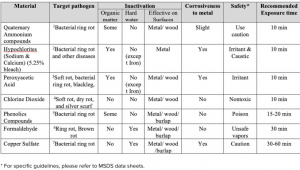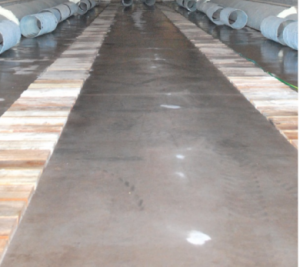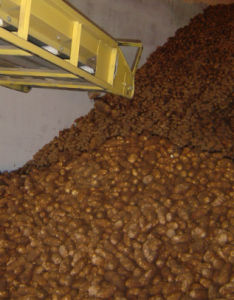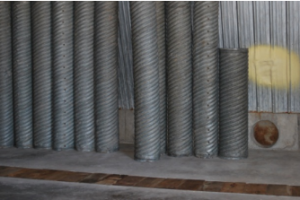By S. Jayanty (1/2021)
Quick Facts…
- Storages and handling equipment should be cleaned and sanitized before and after use.
- A cull pile is a potential source of many diseases (soft rot, ring rot, late blight, viruses)
To prepare a satisfactory storage environment before the loading of a fresh harvest of potatoes into storages, a variety of disinfectants are used for cleaning the potato storage facilities and potato handling equipment. It is a general
phytosanitary measure to reduce pest and disease issues in potato storage and handling equipment. Implementing good routine hygiene measures and practices for workers and machine operators is critical. Some pathogens, such as the silver scurf pathogen, may survive from one season to the next and ring rot from 3 to 7 years, depending on the type of storage facility. Disinfection of storage and handling equipment is a three-step process. The following are essential steps in preparing the storage:
Cleaning the Storage and Surroundings
- An unclean storage building cannot be sanitized. Since sanitization effectiveness requires direct contact with the pathogens, the surface should be free of cracks, pits, or crevices that can harbor microorganisms.
- Efficient cleaning starts at the top of equipment and working down.
- Removing plant and soil residue from the storage and equipment. Pathogens thrive on organic debris.
- Cleaning the floor of storages and warehouse with an industrial vacuum cleaner is the best option because sweeping can distribute pathogen spores along with dust.
- Removing potato debris and other trash from within and around storage facilities from the previous crop.
- Wind gusts in the early spring or early fall may bring inoculum into the storage or packaging facilities. Burn, chop, compost, freeze or bury discarded potatoes.
- If the storage has a dirt floor, it is advisable to remove 1 to 2 inches of soil and replace with soil from healthy non-potato growing field. Remove all dust, dirt, and sprout inhibitors from fan blades.
Washing with Steam and Soap
- Effective sanitation requires a thorough cleaning of all surfaces before a disinfectant is applied.
- Wash the storage bins, walls, and machinery floor with hot soapy water using a high-pressure washer and
follow by rinsing with water. - A high-pressure washing with a nonfoaming industrial detergent, or steam-cleaning, may be appropriate in certain situations, such as wooden crates, where damage will not result.
- Soil, clay particles, and organic material quickly neutralize the biocidal properties of most disinfectant materials.
- Steam exposure time should be five seconds for fresh, wet bacterial material and 20 seconds for dried bacterial material.
- If a detergent is used for washing, it should be rinsed off before a chemical disinfectant is used. Disinfect equipment and the storage structure with recommended materials (see below).
Disinfection
It is crucial to ensure that the rate of application of chemical disinfection is correct for the method of application. The efficacy of disinfection may vary according to the surface type, temperature, and water hardness. Rinsing is necessary when using corrosive disinfectants.
Recently, the use of wooden crates to store potatoes has been increasing to reduce pressure bruise incidence in long-term storage. Apply disinfectant directly on wooden crates, without washing with water. Washing first with water will fill the crevices and cracks, preventing contact with the disinfectant. Recently published literature shows that foam application mediates the adherence of a higher amount of disinfectant solution to the wood surface compared to fluidal spray application. Foaming delays the drying process, and therefore the disinfectant’s reaction time is extended, and the probability of disinfection success increases.
In general, disinfectants must contact the surface to be disinfected for a minimum of 10 minutes to kill bacteria.
A foaming agent can be added to some disinfectants to help the chemical stay in place, such as on a wall, for 10
minutes to penetrate the fungal cell wall or dissolve the bacterial slime and kill the pathogen
- Spray areas using a high-pressure jet (up to 4250 kPa pressure) to penetrate cracks, etc., on floors. When spraying on equipment, care must be taken to avoid stripping paint.
- Wood surfaces can be treated with a wood preservative such as copper-8-quinolinolate, which is fungicidal and bactericidal.
- Fumigants or fogs may be appropriate in some
cases. - After disinfection, rinse well with cold or hot water
and remove excess water. - The choice of disinfectant used depends upon the specific pathogens being targeted and the type of storage structure (i.e., wood vs. metal). Another factor might include the availability of disinfectants, application methods available like fogging vs. foam vs. liquidspray, etc.
- The efficacy of sanitation may vary according to the surface type, temperature, and water hardness. Best results are temperatures of 15–20°C.
Guidelines for disinfecting potato handling equipment and storage structures
Notes
- Copper Sulfate: Good residual activity, mostly for soaking crates and bags, may cause some staining.
- Formaldehyde: Not generally recommended. Produces irritating, choking fumes. Follow OSHA directions
regarding exposure, potential human carcinogen! - Hypochlorites, 5.25% bleach: Quick-acting, inexpensive; caustic to skin and clothing, very corrosive.
- Hydrogen peroxide/Peroxyacetic acid: Can be applied directly to potatoes, no residue, low corrosiveness,
with use of heat it can be applied as a fumigant in the air system. - Phenolic Compounds: Provide residual action.
- Quaternary Ammonium Compounds: Less affected by organic matter or soil, water pH is not critical, slightly
corrosive, use stainless. - It is challenging to kill ring rot bacteria in contaminated burlap bags. If possible, contaminated bags should
be burned. Do not reuse contaminated bags for handling seed potatoes.
References
- Howard RJ, Harding MW, Daniels GC, Mobbs SL, LisowskiSLI & De Boer SH (2015). Efficacy of agricultural
disinfectants on biofilms of the bacterial ring rot pathogen,Clavibacter michiganensis subsp.Sepedonicus.
Canadian Journal of Plant Pathology. 37(3) 273-284. https://doi.org/10.1080/07060661.2015.1078413. - Stevens LH, Lamers JG, van der Zouwen PS, Mendes O,. van den Berg W, Tjou-Tam-Sin NNA, Jilesen CJTJ,
Spoorenberg PM.& van der Wolf JM. (2017). Chemical eradication of the ring rot bacterium Clavibacter
michiganensis subsp. sepedonicus on potato storage crates. Potato Research 60:145–158. - Bacterial soft rot of vegetables, fruits, and ornamentals. https://ipm.illinois.edu/diseases/rpds/943.pdf
- Olsen NL, Kleinkopf GE, & Woodell LK. (2003). Efficacy of chlorine dioxide for disease control on stored
potatoes. American Journal of Potato Research 80(6):387-395 DOI: 10.1007/BF02854250 - Bacterial ring rot on potatoes. http://mtvernon.wsu.edu/path_team/Potato-bacterial-ring-rot-WSU-ExtensionFact-Sheet-FS102E.pdf.
- Disinfection procedures in potato production (2006). European and Mediterranean Plant Protection
Organization Bulletin OEPP/EPPO Bulletin 36, 463–466. - Diseases of potato ring rot. MSU Ag Facts Extension Bulletin E-1801, July 1985.
https://archive.lib.msu.edu/DMC/Ag.%20Ext.%202007-Chelsie/PDF/e1801-1985.pdf








